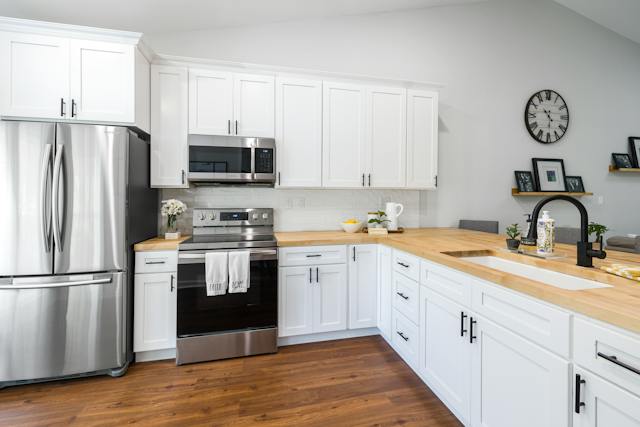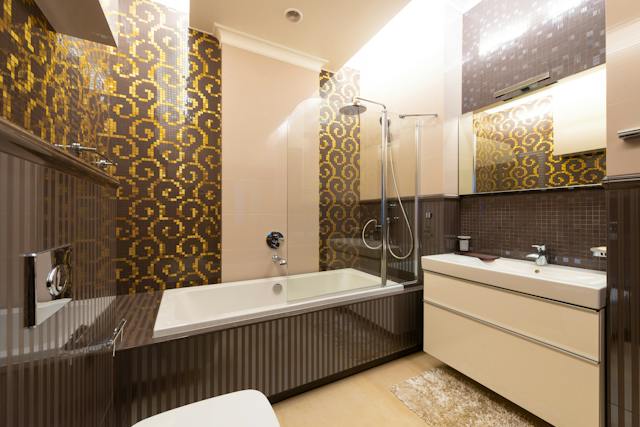
When it comes to improving the look and functionality of your home, two approaches stand out: refinishing and renovation. While both aim to enhance your living space, they tackle the task in very different ways. Understanding the distinctions between these approaches is crucial to making the right decision for your home improvement project.
Refinishing vs Renovation: Snap Comparison
| Refinishing | Remodeling | |
| Cost | $150 to $1,080 for bathroom tile refinishing, while countertop refinishing typically ranges from $300 to $500 | $12,000 to $60,500 for a kitchen remodel and $6,628 to $17,532 for a bathroom remodel |
| Timeline | 3-4 days to refinish a kitchen countertop or bathroom vanity | 2 months to remodel a bathroom |
| Pros | Minimal disruption, eco-friendly, preserves character | Aesthetic and functional improvements |
| Cons | Limited functionality changes, surface-level improvement only | Stressful and extensive process |
| Customization | Limited customization | Full customization and modernization |
Refinishing: Breathing New Life into Existing Surfaces
Refinishing involves restoring or enhancing the existing surfaces in your home. Instead of replacing entire fixtures or structures, refinishing focuses on restoring and enhancing what you already have. This process is often applied to areas such as bathtubs, showers, kitchen countertops and cabinets, and even hardwood floors. The primary purpose of refinishing is to breathe new life into worn, faded, or damaged surfaces, giving them a renewed and vibrant look without the need for extensive renovations.
Refinishing encompasses a variety of projects that target different areas of your home. Here are some common refinishing projects:
- Painting
- Staining
- Refinishing cabinets
- Bathtub refinishing
- Countertop refinishing
Benefits of Refinishing
Refinishing is not just about giving a fresh look to tired or worn items; it offers a multitude of advantages beyond aesthetics. Here are some benefits of refinishing:
Cost-Effectiveness
Refinishing is generally more budget-friendly than a full renovation. For bathroom tile refinishing, you can expect to spend between $150 to $1,080, while countertop refinishing typically ranges from $300 to $500. By focusing on surface-level improvements, you can achieve a significant transformation without breaking the bank.
Less Disruption
Refinishing projects are usually quicker to complete compared to renovations. It takes 3-4 days to refinish a kitchen countertop or bathroom vanity, for instance. This means less inconvenience for you and your family, as well as a shorter disruption to your daily routine.

Eco-Friendly
Opting for refinishing helps reduce waste by avoiding the need to replace entire fixtures or structures. It’s a greener choice that contributes to sustainability.
Preserves Character
Refinishing maintains the original charm and character of your space. If you’re attached to the history of your home, this approach can help preserve its unique features.
Limitations of Refinishing
When it comes to revitalizing your living space, refinishing is often the first option that comes to mind. It’s a cost-effective way to give your home a fresh look without breaking the bank. However, it’s not the right solution in every situation.
It’s essential to acknowledge the inherent limitations of refinishing as it can only address issues at the surface level. Here are some situations when refinishing might not be the right solution:
Structural Problems or Layout Issues
If your project involves significant structural modifications or adjustments to the layout of a room, refinishing alone may not be the appropriate solution, and a more comprehensive renovation may be required.
Limited Functionality Changes
While refinishing is great for restoring the appearance of surfaces, it cannot address deeper issues or accommodate significant alterations in functionality, such as updating outdated plumbing systems or reconfiguring living spaces.

Inadequate for Personalized Transformations
While refinishing is excellent for restoring and refreshing existing surfaces, it may fall short when it comes to personalized transformations. Refinishing often lacks the scope for extensive customization needed to fulfill ambitious and highly individualized home improvement projects, making renovation a more suitable choice for those seeking truly unique and personalized spaces.
Renovation: Crafting a Fresh Vision
Renovation is the process of revitalizing, improving, or completely transforming a space, often with the goal of enhancing its functionality, aesthetics, and overall value. This could mean completely overhauling a room, remodeling a kitchen, or even adding new rooms to your home.
The purpose of renovation goes beyond surface-level improvements; it seeks to address the evolving needs and desires of homeowners. Whether you want to breathe new life into a dated interior, make your home more energy-efficient, or adapt it to changing lifestyle requirements, renovation is the means to achieve those goals. It’s an intentional investment in your living space, driven by the desire to create a home that better aligns with your vision and lifestyle.
Common renovation projects include:
- Remodeling
- Replacing fixtures and fittings
- Installation of new countertops, cabinets, and appliances
- Energy efficiency upgrades
- Exterior renovations like adding a new roof, landscaping, or updating the siding and façade
Benefits of Renovation
Renovation isn’t just about making changes to your home; it’s about creating a whole new living space that truly reflects your vision and lifestyle. Here are some of the advantages of renovation:
Customization and Modernization
Renovation allows you to tailor your living space to your exact preferences. You can modernize outdated areas and design a layout that suits your lifestyle.
Aesthetic and Functional Improvements
Renovations address both aesthetic concerns and functional limitations. This comprehensive approach can dramatically enhance the usability and beauty of your home.

Energy Efficiency and Technology Integration
Renovations offer the chance to integrate energy-efficient features and modern technologies, making your home more sustainable and convenient.
Limitations of Renovation
While renovation offers the promise of comprehensive changes and the opportunity to create your dream home, it comes with its fair share of downsides that need careful consideration.
Higher Cost
One of the most significant downsides of renovation is the substantially higher cost compared to refinishing. Prepare to spend $12,000 to $60,500 for a kitchen remodel and $6,628 to $17,532 for a bathroom remodel. The cost increase is often driven by structural changes, skilled professionals, permits, and the use of high-quality materials. It’s essential to have a clear budget in mind before embarking on a renovation project.
Extended Timelines
Renovation projects typically take considerably longer to complete than refinishing. A bathroom remodel, for example, can take two months to complete. Extended timelines are a result of the complexity of the work and potential delays. The process can be time-consuming, inconvenient, and disruptive for you and your family. Patience is key during this process.
Stressful Process
Renovation can be a stressful process, as it involves making big, important decisions, coordinating with contractors, and dealing with unexpected issues that may arise during the project. It’s essential to be prepared for the emotional and logistical challenges that can come with renovation.
Factors to Consider When Choosing Between Refinishing and Renovation
Several factors come into play when deciding between refinishing and renovation:
- Budget
Assess your budget and determine which approach aligns with your financial capabilities.

- Goals and Priorities
Consider whether you’re looking for surface-level improvements or a complete overhaul.
- Condition of the Space
Evaluate the extent of damage or outdated features to determine which approach is more suitable.
- Timeline
Determine how urgently the changes need to be implemented and whether you’re willing to endure a longer renovation process.
- Personal Preferences
Reflect on your attachment to the existing space and your satisfaction with preserving original elements versus creating something entirely new.
When it comes to making the decision between refinishing and renovation, there’s no one-size-fits-all answer. It ultimately depends on your unique circumstances and goals. Consider your vision for your home—whether you seek surface-level improvements or a complete overhaul. Reflect on your long-term plans for the property. Will your changes align with your future needs? Weighing these factors will guide you toward the right path for your home improvement project. Remember, there’s no rush; take your time to deliberate and choose wisely.




Leave a Reply